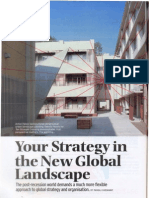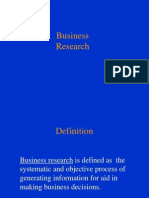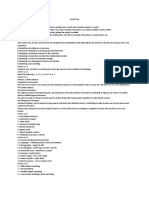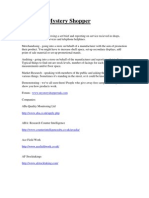How Strong Is China
How Strong Is China
Uploaded by
Shashank ShashuCopyright:
Available Formats
How Strong Is China
How Strong Is China
Uploaded by
Shashank ShashuOriginal Description:
Original Title
Copyright
Available Formats
Share this document
Did you find this document useful?
Is this content inappropriate?
Copyright:
Available Formats
How Strong Is China
How Strong Is China
Uploaded by
Shashank ShashuCopyright:
Available Formats
How strong is Chinas economy?
By Sushil Seth
There is a growing fear that the world might be heading toward an
economic Armageddon, with the eurozone crisis looking increasingly
intractable by the day. The US economy, too, is in a holding pattern
with not much light ahead. In such times the Chinese economy
appears healthy, though its rate of growth is slowing. However, this is
not to say that China is trouble-free.
Chinas economy has some deep-rooted problems that do not augur
well for its future. This is the assessment of Chinese Premier Wen
Jiabao (), who said some time ago: We must ... address the
long-standing problems in Chinas economy of a lack of balance, poor
coordination and unsustainability...
If anyone else had said this, he would have been laughed out of town,
because Chinas is a slower growth rate of about 9 percent is a rate
most other countries would die for.
Chinas growth strategy has been underpinned by three important
factors.
First, it has been export-driven, with seemingly unlimited demand for
Chinese goods in the US, Europe and even among developing
countries.
Second, production costs in China are low because of low wages and
long working hours, which gives China an important and decisive
competitive advantage compared with other countries.
Third, an undervalued currency further enhances Chinas competitive
advantage. Not surprisingly, Chinese goods have flooded international
markets to undercut local production with consequent job losses.
Until the global financial crisis hit the world in 2008, the availability
of cheap and easy credit had not created too much resentment in the
West against Chinese exports. For instance, with China buying US
treasury notes and bonds with recurring and expanding trade
surpluses, and its cheap goods helping to keep inflation under control,
it did not seem like a huge problem.
However, all this is changing, for a number of reasons. First, Chinas
export markets in Europe and the US are shrinking because of severe
economic problems in these countries. They simply cannot afford to
keep buying Chinese goods as they did before.
Second, these countries, especially the US, have been pressuring
China to revalue its currency to create a level playing field for their
exports to China. Because of Chinas resistance to freely floating its
currency, protectionism is rising in the US.
At the same time, labor unrest in China has put wages under upward
pressure. This competitive advantage might diminish as labor costs
rise.
With the rise of protectionism and rising labor costs, the export-driven
growth strategy might not be as attractive as it has been for the past 30
years.
China will, therefore, need to reorient its economy to produce goods
and services for internal consumption, because any slow or sluggish
growth will worsen unemployment and lead to social unrest.
The problem, though, is that it is not like switching gears in a car to
change the direction of an export-driven economy to focus on creating
and meeting internal demand. The state has to have a road map for this
and a strategy to execute it. Beijing has no such plan.
When the global recession hit in 2008 affecting Chinese jobs and
exports, Beijing sought to meet the situation with a hefty stimulation
package of about US$600 billion. However, this also created a
property bubble and led to wild stock market fluctuations.
14 Sources of Competitive Advantage
Competitive advantage comes from many places beyond simply the
product and service and below I have outlined 14 possibilities for
advantage. They are supported by considerable data, research and experience;
the data sources are included in a bibliography below for your reference.
Sources of competitive advantage lie all along the value chain based on
Michael Porters seminal work, Competitive Advantage and famously depicted
below.
With so many options, how do you know the right
competitive advantage for your business? It needs to be
unique and to lower buyer cost or raise buyer performance
through the impact of its value chain on the buyers value
chain.(1) Notice here the dollars and cents value impact on
your customers. It is only real competitive advantage when
it accomplishes this.
Feel free to contact us to determine and possibly assist with
the implementation of the most effective differentiator for
your firm.
Leadership: Sources of Competitive Advantage
Here, I have replaced Michael Porters infrastructure with
top managements role, which inevitably cuts across
departments or involves the external environment. We
begin with examples of the companys strategies and impact
on the external environment.
Externally-focused Strategies
1. Localization in Global
Markets
Implementing simultaneous strategies of localization and
globalization in global market returned Panasonic to a
profitable growth path. In 2000, the company suffered its
first loss due to Chinese competitors effectively exporting to
the US, Europe and South Asia. In response, Panasonic
shifted from a US-based to a global view. It set up a center
focused both on local Chinese market needs and on globally
available and soon-to-be available Panasonic products. The
center uncovered a need for narrower refrigerators, allowing
fridge sales to increase ten-fold in one year. It also found a
need to sterilize laundry. Panasonic was the first major
player to bring this capability to market. As a result, the
front-loaded washer market share in China increased from
3% to 15%. (3)
2. Strategic Alliance or Acquisition
Strategic Alliances are an important source of capabilities a
firm may not otherwise possess. Few firms have all the
capabilities needed to compete effectively in our world of
fast-paced change. Despite the fact that an alliance is
formed nearly every 90 seconds, failure rates appear to
occur in nearly 60 percent of all alliances.(4) In most
instances, failure is not a function of the alliance being a bad
strategic option; rather, failure is attributable to managerial
error.(4) Consequently, successful strategic alliances can
bring significant competitive advantage.
Another option is to purchase the capability. At Sonoco
Retail Packaging, we could see that our ability to pack retail
products would be complemented by the ability to design,
manufacture and pack out popular point-of-purchase
displays. As a result, we acquired a premier POP display
company, yielding an important capability that customers
needed, and so generating additional sales and profits.
3.
Competitive Actions
Following an extensive study of competitive actions and
responses in the airline industry, Ming-Jer Chen concludes
that the more responses a companys competitive action
provokes, the more that companys profits drop. (5) Highly
visible attacks to the core of competitors will draw a lot of
response, as confirmed by airline data. Competitive attacks
that are difficult to respond to draw less reaction, as
demonstrated by considerable airline data in the study.
Attacks that are difficult to respond to include those that
demand a costly response, significant organizational change,
or sophisticated coordination among different departments.
These are the competitive actions companies will want to
make.
Still, effective competitive actions can vary by environment.
In nascent markets, plenty of ambiguity exists and investors
prefer companies with more predictable and simple
competitive moves. This encourages improved investor
valuation and so offers competitive advantage. (6)
4. Customer Clusters
Research has shown that firms located near customers
cluster innovate more quickly. (7, 8) This is largely due to
more customer participation and a real-time information
flow. Far flung customers makes it more difficult to assess
and maintain satisfaction. (7)
Internal Leadership Role
5. Company-Wide Market Orientation
Too many companies merely give lip service to focusing on
the market and customers. A real market orientation
involves offering more customer value due to an outstanding
understanding of the
customer and competitors that permeates the organization.
Based on 9 years of data, Kumar et al find that market
orientation has a positive effect on business performance in
the short and the long run. It can take some time for the
market orientation to have a positive effect, so management
needs to provide support. At the beginning of the 9 year
period, a company with a market orientation had an
advantage. Later on, the nature of competition changed and
a market orientation was necessary to compete successfully.
Still, the study finds that under highly competitive pressure,
a company can gain advantage with a market orientation.
(9)
At a multi-million packaging company, I led the shift from a
product to a market focus. Initially, the company produced
the plethora of products the equipment could produce. As a
result, the company was mediocre in most markets, and
poorly performing in some, having suffered a significant loss
the previous year. I coached the management team to
explore market options, utilizing the extensive knowledge in
Sales, Production and market analyst assistance. Given the
companys sophisticated capabilities, market trends and the
high margins, we selected the high end market segment as
an area of focus, shedding the high volume, low margin
product lines. The company pulled together to pursue high
quality packaging accounts and to move into a new, higher
end product line. The new business added considerable
profits to our bottom line, returning the company to
profitability.
6. Strategic Fit between Marketing and
Manufacturing
Organizing marketing activities in ways that fit a businesss
strategy type can form a significant source of competitive
advantage. (10) The crux of this is to ensure the customer
requirements of the companys marketing strategy are met
by the manufacturing strategy. Misalignments need to be
identified and transformed into strategic fit.
Strategic fit between
marketing and manufacturing can drive such strong
relationships of trust and reputation that the potential
exists for any organization to develop intimate relations with
customers to the point that they may be relatively rare and
difficult for rivals to replicate(11). The best products do
not necessarily win. The best-networked ones usually do.
(10) This phrase highlights the necessary partnership of
manufacturing and marketing.
For manufacturing-focused companies, it is essential to note
that three organizational challenges at the heart of
entrepreneurial strategy fall squarely in the bailiwick of
marketing: (1) scanning and projecting current, emerging
and potential environmental change; (2) Perceiving the
outlines of potential opportunity lurking but rarely
manifestly evident in such change; and (3) Translating
(perceived) opportunity into (potential) solutions that
generate value for some set of customers. Effective
marketing is essential to a successful company. (11).
7. Implementation of Strategy
It is possible to compete successfully with superior
implementation of strategy rather than superior strategy.
(12) As markets become more mature, the environment
becomes less dynamic and there are fewer opportunities to
develop a better product or new strategy. Consequently,
superior implementation can win the day.
It is important to realize that an implementation leader has
an internal focus, possessing great organizational and
motivational abilities while a strategy of differentiation
demands a leader with an external focus who is a great
strategist brilliant, capable of seeing what others do not
see while (12)
Human Resources: Sources of Competitive
Advantage
8. Human Capital
Human capital in the form of a highly trained workforce can
be the source of competitive advantage, particularly if
employees do not take their skills to competitors. (13, 14)
Firm-specific capital is not valuable when transferred to a
new firm, and so it in particular is a good source of
competitive advantage. (15, 16) However, if a firm is able to
retain employees then the skills of interest to competitors
can be a source of competitive advantage. (15, 16)
9.
Employee Engagement
Many studies demonstrate that employee engagement can
be a source of competitive advantage. One study, taking
place in the labor-intensive hotel industry, found that the
highly satisfied, motivated, committed and fully engaged
employees yielded a higher market share than their
competitor. (18)
Technology Development: Sources of Competitive
Advantage
10. Technological
Change
In this time of great technological advances, there are many
opportunities for gaining competitive advantage through
technological innovation. However, a company needs to
create a culture that is open to adopting new technology
effectively. One study concerning adopting electronic data
interchange (EDI) in the automotive industry notes that the
company benefited from: cost saving, time saving,
increased efficiency, better communication, less error and
delays. Consequently, customer satisfaction and
performance level has been dramatically increased. (19)
However, the value is only achieved with the selection and
effective implementation of the correct technology, which is
not easy.
11. Business Analytics
Recently, 58% of the more than 4,500 respondents to a
survey conducted by MIT Sloan Management Review, in
partnership with the IBM Institute for Business Value, said
their companies were gaining competitive value from
analytics up from just 37% who said that last year. (20)
Data-oriented cultures implement analytics more effectively.
However, creating this culture can be difficult. 44% of
respondents considered organizational challenges difficult
to resolve as compared to 21% who found them easy to
handle. Those early in business analytic implementation
find these issues most difficult. (20)
Logistics and Operations: Sources of Competitive
Advantage
12. Production System
Implementing an effective production system can bring
companies competitive advantage. One study shows that
industrial companies in Jordan who implemented Just-In-
Time (JIT) attained positive and statistically significant
advantages in costs, quality and financial results. (21) At an
RR Donnelley facility I ran, we implemented JIT in a small
run, quick turn pressroom. It yielded considerable customer
satisfaction and maintained sales in a highly competitive
market.
13. Business Processes
Managing consistent business process seamlessly is another
source of competitive advantage. For example, Toyota added
product value due to the Six Sigma and product design
processes. Business process improvement can be a cost-
effective strategy as it can occur without technological
change. However, it is critical that the processes are tied
closely to the business strategy and objectives. (22)
Government Programs: Sources of Competitive
Advantage
14. National Export Promotion
Countries adopting specific export promotion programs can
offer companies competitive advantages in products,
services and costs. This has a stronger positive effect on
smaller firms and those less experienced in exporting. (23)
Conclusion
There are many possible sources of competitive advantage.
As mentioned, the key is that the chosen advantage would
provide value to your market. Feel free to contact us to
determine and possibly assist with the implementation of
the most effective differentiator for your firm.
You might also like
- International Management Managing Across Borders and Cultures Text and Cases 9th Edition Deresky Solutions Manual DownloadDocument26 pagesInternational Management Managing Across Borders and Cultures Text and Cases 9th Edition Deresky Solutions Manual DownloadByron Lindquist100% (28)
- Plumbing Company Marketing PlanDocument20 pagesPlumbing Company Marketing PlanPalo Alto Software100% (3)
- BBPS4103Document12 pagesBBPS4103Ervana Yahya100% (1)
- ING Direct Case Study AnaysisDocument7 pagesING Direct Case Study AnaysisAbby Leigh GrabitzNo ratings yet
- Cash ManagementDocument19 pagesCash ManagementShashank ShashuNo ratings yet
- GMC Case StudyDocument3 pagesGMC Case StudyAnish SinghNo ratings yet
- CH 10 GREE Case StudyDocument15 pagesCH 10 GREE Case StudyPriyanka PiaNo ratings yet
- Bruce R. Barringer R. Duane Ireland: Fourth Edition Global EditionDocument10 pagesBruce R. Barringer R. Duane Ireland: Fourth Edition Global EditionWin BoNo ratings yet
- Triple 10 Sun Oil Gasoline Station Company ProfileDocument5 pagesTriple 10 Sun Oil Gasoline Station Company ProfileWendy May Villapa67% (3)
- Building To Win-FinalDocument51 pagesBuilding To Win-FinalKathrin BotaNo ratings yet
- Your Strategy in The New Global LandscapeDocument6 pagesYour Strategy in The New Global LandscapeSourabh DuttaNo ratings yet
- Customer Trends: Opportunities For Coty Inc. - External Strategic FactorsDocument11 pagesCustomer Trends: Opportunities For Coty Inc. - External Strategic FactorsWongsatorn WorakittikulNo ratings yet
- 10 Reasons To Go InternationalDocument5 pages10 Reasons To Go InternationalRIzwan SaleemNo ratings yet
- Accenture Emerging Market EntryDocument16 pagesAccenture Emerging Market EntryPrateek JainNo ratings yet
- Third Point Q4 2014Document8 pagesThird Point Q4 2014marketfolly.com100% (1)
- Chapter 11Document9 pagesChapter 11oranghebat0% (1)
- Student I.D: - M. Arib 16628 - Date: 8/1/2021 8/908/Jan/2021Jjjjjunejune - Course Code: Mkt-351 Teacher Name: Abdullah Khan Program: Bba-2Y Marks: 40Document18 pagesStudent I.D: - M. Arib 16628 - Date: 8/1/2021 8/908/Jan/2021Jjjjjunejune - Course Code: Mkt-351 Teacher Name: Abdullah Khan Program: Bba-2Y Marks: 40Syed Ahmer Hasnain JafferiNo ratings yet
- M&S Expansion Into China 21.01.12Document17 pagesM&S Expansion Into China 21.01.12Bev CoxNo ratings yet
- "Fundamental Analysis of Voltas": P.E.S Institute of Technology Department of MBADocument17 pages"Fundamental Analysis of Voltas": P.E.S Institute of Technology Department of MBAJennifer SmithNo ratings yet
- The Warc Prize For Asian Strategy 2012 - Entry Tips: Made A Number of CommentsDocument8 pagesThe Warc Prize For Asian Strategy 2012 - Entry Tips: Made A Number of Commentslalou4No ratings yet
- The Strategy of IBDocument3 pagesThe Strategy of IBRahul BanerjeeNo ratings yet
- SCM Perfect Prod LaunchDocument12 pagesSCM Perfect Prod LaunchHaris JanooNo ratings yet
- Fundamental Analysis A Conceptual OverviewDocument16 pagesFundamental Analysis A Conceptual OverviewKhaja Gulam PathanNo ratings yet
- Pros of Expanding AbroadDocument10 pagesPros of Expanding Abroadjual76No ratings yet
- Chap 2 Michael Pettus Strategic Decision MakingDocument6 pagesChap 2 Michael Pettus Strategic Decision MakingSo PaNo ratings yet
- SSRN Id3594916Document14 pagesSSRN Id3594916Nashid alamNo ratings yet
- 10 Reasons To Go International PDFDocument5 pages10 Reasons To Go International PDFHabiba KausarNo ratings yet
- 10 Reasons To Go International PDFDocument5 pages10 Reasons To Go International PDFHabiba KausarNo ratings yet
- Module 8 AssignmentDocument5 pagesModule 8 AssignmentMuafa Basheer100% (1)
- Global Exame Questions 4Document4 pagesGlobal Exame Questions 4Sukh RajputNo ratings yet
- International Economics 6th Edition James Gerber Solutions Manual 1Document7 pagesInternational Economics 6th Edition James Gerber Solutions Manual 1judith100% (61)
- It Short Notes.Document8 pagesIt Short Notes.kodob96388No ratings yet
- Reflection Paper 4Document7 pagesReflection Paper 4Victor Muchoki100% (1)
- Global Strategic Management Report: Topic-Strategy in Emerging MarketsDocument5 pagesGlobal Strategic Management Report: Topic-Strategy in Emerging MarketsGautam Siddharth SharmaNo ratings yet
- Ess WoolDocument11 pagesEss WoolRadu MirceaNo ratings yet
- Business Management and Strategy TEST NO. 4 (CH 8 - 9)Document2 pagesBusiness Management and Strategy TEST NO. 4 (CH 8 - 9)Asad AliNo ratings yet
- Cost MGMT To Cost L'shipDocument5 pagesCost MGMT To Cost L'shipvjjani2204No ratings yet
- Critical Thinking and Discussion Question (Chpter8)Document3 pagesCritical Thinking and Discussion Question (Chpter8)Qasih Izyan100% (3)
- Global EconomyDocument4 pagesGlobal EconomyEldar SofticNo ratings yet
- CH 3 NewDocument12 pagesCH 3 Newbire brightNo ratings yet
- Deutsche BrauereiDocument38 pagesDeutsche BrauereiTazkia Munia0% (1)
- Ravshan Suyunov Final EnterpreneurshipDocument5 pagesRavshan Suyunov Final EnterpreneurshipzazaNo ratings yet
- Economic Factors PESTELDocument11 pagesEconomic Factors PESTELnatalie_calabreseNo ratings yet
- The Strategy of International Business: Chapter OutlineDocument21 pagesThe Strategy of International Business: Chapter OutlineManzar HussainNo ratings yet
- Challenges of GlobalizationDocument28 pagesChallenges of GlobalizationMOQUDASNo ratings yet
- Bmbs Marks:35 Test Chapter 2Document5 pagesBmbs Marks:35 Test Chapter 2Arslan Arif100% (1)
- Case 8Document5 pagesCase 8Zayn LachowskiNo ratings yet
- Strategic Audit of Samsung Corporation: Analysis of Strategic Factors - Based On The SWOT Analysis and TheDocument16 pagesStrategic Audit of Samsung Corporation: Analysis of Strategic Factors - Based On The SWOT Analysis and TheAmi Imran100% (1)
- MB0052 SLM Unit 10Document30 pagesMB0052 SLM Unit 10SarlaJaiswalNo ratings yet
- Industry Analysis On Ice Cream Industry MBAHOTSPOTDocument19 pagesIndustry Analysis On Ice Cream Industry MBAHOTSPOTShivang Kamboj100% (1)
- Business ManagementDocument5 pagesBusiness ManagementKhanNo ratings yet
- Generic Strategy and CSR Strategy Analysis and Its Implementation. Case Study: B&Q. Author: Ashim Chakraborty, MBA MSCDocument20 pagesGeneric Strategy and CSR Strategy Analysis and Its Implementation. Case Study: B&Q. Author: Ashim Chakraborty, MBA MSCashimcb2006No ratings yet
- End of Chapter Question and AnswersDocument31 pagesEnd of Chapter Question and AnswersAleena AmirNo ratings yet
- Achieving Superior Financial Performance in ChinaDocument5 pagesAchieving Superior Financial Performance in Chinaghdbakjd100% (1)
- Chapter 8 Study GuideDocument5 pagesChapter 8 Study GuideHieu NguyenNo ratings yet
- BB Strategies For GrowthDocument8 pagesBB Strategies For GrowthGustavo MicheliniNo ratings yet
- BUS 475 Week 2 Knowledge CheckDocument7 pagesBUS 475 Week 2 Knowledge CheckErika ToniNo ratings yet
- The Five Types of Successful AcquisitionsDocument7 pagesThe Five Types of Successful AcquisitionsConsulter TutorNo ratings yet
- The Well-Timed Strategy (Review and Analysis of Navarro's Book)From EverandThe Well-Timed Strategy (Review and Analysis of Navarro's Book)No ratings yet
- Competition Demystified: A Radically Simplified Approach to Business StrategyFrom EverandCompetition Demystified: A Radically Simplified Approach to Business StrategyRating: 4 out of 5 stars4/5 (15)
- Model Answer: E-Commerce store launch by Unilever in Sri LankaFrom EverandModel Answer: E-Commerce store launch by Unilever in Sri LankaNo ratings yet
- Trade and Competitiveness Global PracticeFrom EverandTrade and Competitiveness Global PracticeRating: 5 out of 5 stars5/5 (1)
- Cash Is King: Maintain Liquidity, Build Capital, and Prepare Your Business for Every OpportunityFrom EverandCash Is King: Maintain Liquidity, Build Capital, and Prepare Your Business for Every OpportunityNo ratings yet
- Strategies for Successful Small Business Ownership in an Unstable EconomyFrom EverandStrategies for Successful Small Business Ownership in an Unstable EconomyRating: 5 out of 5 stars5/5 (2)
- Competitive Advantage of China:: Currency AppreciationDocument6 pagesCompetitive Advantage of China:: Currency AppreciationShashank ShashuNo ratings yet
- CH 01Document14 pagesCH 01Shashank ShashuNo ratings yet
- Service Marketing AssignmentDocument10 pagesService Marketing AssignmentShashank ShashuNo ratings yet
- Synopsis: Microfinance - An OverviewDocument6 pagesSynopsis: Microfinance - An OverviewShashank ShashuNo ratings yet
- Case Study On BT BrinjalDocument12 pagesCase Study On BT BrinjalShashank ShashuNo ratings yet
- Alva'S College,: On "Employees Environment, Health and SafetymeasuresDocument99 pagesAlva'S College,: On "Employees Environment, Health and SafetymeasuresShashank Shashu50% (2)
- Accounting Ledgers and Entries in GST: CMA Bhogavalli Mallikarjuna GuptaDocument6 pagesAccounting Ledgers and Entries in GST: CMA Bhogavalli Mallikarjuna GuptaRohan KulkarniNo ratings yet
- Mars-Wrigley Deal 1Document8 pagesMars-Wrigley Deal 1Narain KishoreNo ratings yet
- Civil Law - Tuazon v. Del Rosario-Suarez, Et Al.. G.R. No. 168325, December 8, 2010Document2 pagesCivil Law - Tuazon v. Del Rosario-Suarez, Et Al.. G.R. No. 168325, December 8, 2010Dayday Able0% (1)
- Retail Communication ProgramDocument10 pagesRetail Communication ProgramrachealllNo ratings yet
- SWOT AnalysisDocument32 pagesSWOT AnalysisAusLiowLiowNo ratings yet
- Company Profile SSIDocument15 pagesCompany Profile SSIkamphunkNo ratings yet
- Answer Key For MarketingDocument3 pagesAnswer Key For Marketingtammy a. romuloNo ratings yet
- Assign 2sept16 IndividualDocument4 pagesAssign 2sept16 IndividualThiran VinharNo ratings yet
- Eco7 AnalysisDocument11 pagesEco7 AnalysisDewang PalavNo ratings yet
- Advertising Media Planning: A PrimerDocument29 pagesAdvertising Media Planning: A PrimerManav ManochaNo ratings yet
- WwpsDocument13 pagesWwpsKenVictorinoNo ratings yet
- Case Study Sheena CaseletDocument4 pagesCase Study Sheena CaseletPrasad k83% (12)
- Integrated Case Study Complete EditionDocument34 pagesIntegrated Case Study Complete EditionWan Ramss Jr.100% (10)
- B2C EcommerceDocument8 pagesB2C EcommerceSantosh Kumar MiriNo ratings yet
- Strama Paper Jollibee PDFDocument19 pagesStrama Paper Jollibee PDFHunchtrade67% (3)
- Czinkota - IM - Chapter 06Document36 pagesCzinkota - IM - Chapter 06Sumit Suman50% (2)
- Chapter 2Document39 pagesChapter 2bhavya goelNo ratings yet
- Dynamic Item Processor NotesDocument2 pagesDynamic Item Processor NotesAvinash KusamNo ratings yet
- Dormitory ScheduleDocument43 pagesDormitory ScheduleRajapandianNo ratings yet
- Krispy Kreme Doughnuts Inc Competitive Profile (CPM) Matrix: Key Success Factors Weight StarbucksDocument3 pagesKrispy Kreme Doughnuts Inc Competitive Profile (CPM) Matrix: Key Success Factors Weight StarbucksPrecious Diarez PurezaNo ratings yet
- Become A Mystery ShopperDocument9 pagesBecome A Mystery ShopperLisa MyersNo ratings yet
- LifestyleDocument22 pagesLifestylePrajakta Bhoite0% (1)
- Guide Notes On Donor'S Tax Donor'S Tax: Tax 2 Syllabus Associate Dean Lily K. Gruba S/Y 2017-201Document10 pagesGuide Notes On Donor'S Tax Donor'S Tax: Tax 2 Syllabus Associate Dean Lily K. Gruba S/Y 2017-201Jet GarciaNo ratings yet
- Cornerstones: of Managerial Accounting, 5eDocument34 pagesCornerstones: of Managerial Accounting, 5eWidya RahmawatiNo ratings yet
- Ronald Hilton Chapter 3Document25 pagesRonald Hilton Chapter 3Swati67% (3)
































































































